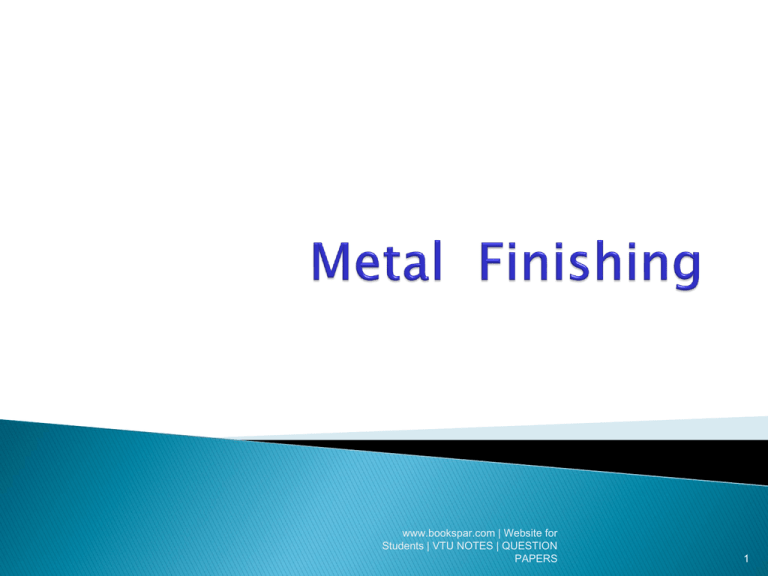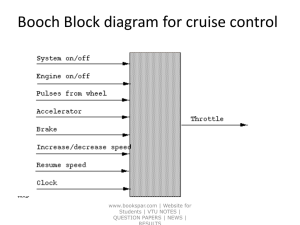Chemistry-Unit-4-Metal-Finishing
advertisement

www.bookspar.com | Website for Students | VTU NOTES | QUESTION PAPERS 1 Process of electro deposition of an adherent metallic film of uniform thickness on the surface of the substrate for the purpose of modifying its surface properties. www.bookspar.com | Website for Students | VTU NOTES | QUESTION PAPERS 2 In general a metal or alloy used for a purpose does not meet all the requirements. Metal finishing is one of the methods employed to improve their lacking properties. www.bookspar.com | Website for Students | VTU NOTES | QUESTION PAPERS 3 Improving resistance to corrosion, scratch or abrasion and wear. Enhancing decorative appearance. Improving solder ability and electrical properties Reducing frictional loss etc. www.bookspar.com | Website for Students | VTU NOTES | QUESTION PAPERS 4 Metal finishing was introduced as a decorative finish, but the increasing demand for parts with prescribed specifications has led to vast technological developments in the field. www.bookspar.com | Website for Students | VTU NOTES | QUESTION PAPERS 5 Techniques of metal finishing: Electroplating of metals & alloys. Electro less plating of metals & alloys. www.bookspar.com | Website for Students | VTU NOTES | QUESTION PAPERS 6 The process by which coating metal is deposited on the base metal by passing direct current through an electrolytic solution, containing the soluble salt of the coating metal. Common metals used are Cu, Ni, Zn, Au, Pt etc. Used in industries for producing metal coating. www.bookspar.com | Website for Students | VTU NOTES | QUESTION PAPERS 7 Decomposition Potential Polarization Over voltage www.bookspar.com | Website for Students | VTU NOTES | QUESTION PAPERS 8 The minimum voltage required for the continuous electrolysis of an electrolyte in an electrolytic cell. In the electrolysis of water, a pair of Pt electrodes is immersed in a solution of an acid. It is found experimentally that a potential of about 1.7 V must be applied to the cell before there sets in a continuous evolution of H2 and O2. www.bookspar.com | Website for Students | VTU NOTES | QUESTION PAPERS 9 During electrolysis accumulation of products of electrolysis around the electrodes causes a back emf which opposes the applied emf. To overcome the back emf, the applied emf will have to be increased ;then only electrolytic deposition starts again. www.bookspar.com | Website for Students | VTU NOTES | QUESTION PAPERS 10 Gradually increasing voltage is applied between the electrodes. Milliammeter reading is noted down for every voltage applied. www.bookspar.com | Website for Students | VTU NOTES | QUESTION PAPERS 11 Decomposition potentials of different electrolytes are different. Strength of the current flowing through the cell Chemical nature of the electrodes. Physical nature of the electrodes Activity of the electrolyte Absolute temperature. www.bookspar.com | Website for Students | VTU NOTES | QUESTION PAPERS 12 Used to carry out all electrolytic processes. (electroplating, electrorefining etc.) Used in the separation of ions from a solution by electrolysis. Two types of ions can be discharged simultaneously by equalising their decomposition potentials. www.bookspar.com | Website for Students | VTU NOTES | QUESTION PAPERS 13 The decomposition of an electrolyte is expected to start as soon as applied potential reaches the value of reversible emf of the cell. But when products discharged at the electrodes are gases, then the actual decomposition potential is invariably much higher than its theoretical reversible electrode potential. The excess voltage is referred to as over voltage of the gas. www.bookspar.com | Website for Students | VTU NOTES | QUESTION PAPERS 14 Over voltage is the difference between the actual applied emf to bring about continuous electrolysis and the theoretical emf needed for such electrolysis. For instance the reversible potential of oxygen gas with smooth Pt electrode is 1.23 V. But actual gas evolution takes place at a potential of 1.68 V. The excess 0.45 V is the over voltage of oxygen on smooth Pt surface. www.bookspar.com | Website for Students | VTU NOTES | QUESTION PAPERS 15 Electrode surface. Nature of the electrolyte. Temperature. Current density. www.bookspar.com | Website for Students | VTU NOTES | QUESTION PAPERS 16 Of the many steps involved in gas evolution at electrodes, at least one is rather a slow process and requires energy. Electrolysis of water: (i) H+ + e -----> H (fast) (ii) H + H -----> H2(slow) The step (ii) being slow, consumes energy and accounts for overvoltage. www.bookspar.com | Website for Students | VTU NOTES | QUESTION PAPERS 17 Development of over potential in an electrolytic cell is called polarization. Electrolytic processes occur at the electrodes of the cell. Polarization sets in the cell when the electrode processes become slow and irreversible. Magnitude of over potential is directly proportional to the extent of polarization. www.bookspar.com | Website for Students | VTU NOTES | QUESTION PAPERS 18 The observed polarization can be of two types. *Concentration polarization. *kinetic or activation polarization. www.bookspar.com | Website for Students | VTU NOTES | QUESTION PAPERS 19 An electrochemical reaction occurs only at the surface of the two electrodes. Adjacent to the electrode surface reactant concentration decreases. The reactant species are transported to the electrode surface by processes like diffusion, migration and convection from the bulk of the solution. www.bookspar.com | Website for Students | VTU NOTES | QUESTION PAPERS 20 Current flowing through the cell drops when the rate of transport is insufficient to match the electrode reaction. A potential than the theoretical value is required to maintain the current at the necessary level. This phenomenon is called concentration polarization. www.bookspar.com | Website for Students | VTU NOTES | QUESTION PAPERS 21 Steps: *Diffusion of reactant species towards the electrode. *Diffusion of product away from the electrode cause concentration polarization. This can be minimized by: * Increasing the convection. * By raising the temperature. * Mechanical agitation of the solution. www.bookspar.com | Website for Students | VTU NOTES | QUESTION PAPERS 22 This is caused when any of the following steps become slow and need activation energy. *Adsorption of the reactant on the electrode. *Charge transfer across the metalsolution interface. *Desorption of the product from the electrode become slow and need activation energy. www.bookspar.com | Website for Students | VTU NOTES | QUESTION PAPERS 23 A higher potential than the theoretical value is to be applied to maintain current at the necessary level. It is not possible to eliminate or minimize kinetic polarization by any means. www.bookspar.com | Website for Students | VTU NOTES | QUESTION PAPERS 24 Activation polarization is *Low: When metal deposition or metal dissolution is the electrode process. *High: When the electrode process is a gas (H2 ,O2, etc) evolution, www.bookspar.com | Website for Students | VTU NOTES | QUESTION PAPERS 25 The electroplating device is essentially an electrolytic cell, in which two electrodes, anode and cathode are dipped in an electrolyte solution. www.bookspar.com | Website for Students | VTU NOTES | QUESTION PAPERS 26 A d.c. electrical power source. Anode : Inert material / coating metal itself. Cathode : Article to be plated. Electrolytic bath: Solution of conducting salt, metal to be plated in a soluble form, buffer and additives. Container: Made up of rubber lined steel, wood or concrete. www.bookspar.com | Website for Students | VTU NOTES | QUESTION PAPERS 27 Anode : Made of coating metal. Cathode: Article to be plated. Electrolyte: CuSO4 solution. CuSO4 Cu2+ + SO42*On passing current, Cu2+ + 2e Cu (Cathode) Cu + SO42CuSO4 + 2e.(Anode) Thus there is a continuous replenishment of electrolytic salt during electrolysis. www.bookspar.com | Website for Students | VTU NOTES | QUESTION PAPERS 28 If the anode is made of some inert material like graphite, then electrolytic salt is added continuously in order to maintain proper coating metal ion concentration in the bath. The process of electroplating goes on nonstop, since the anode is not consumed. www.bookspar.com | Website for Students | VTU NOTES | QUESTION PAPERS 29 The deposit should be bright and lustrous. The deposit should be continuous, uniform, non porous and adhesive. It should be hard and ductile. It should be of fine grained nature. www.bookspar.com | Website for Students | VTU NOTES | QUESTION PAPERS 30 Current Density: An optimum current density should be applied. If low- *leads to slow process *results in coarse grained deposit. If high- *leads to rough and treed deposit. *results in burnt and spongy deposit. www.bookspar.com | Website for Students | VTU NOTES | QUESTION PAPERS 31 Metal salt and electrolyte concentration: Optimum electrolyte concentration should be maintained in bath to get a better deposit. The advantages of using a strong solution: *higher conductivity. * cathode efficiency. * Firm and adherent deposits. www.bookspar.com | Website for Students | VTU NOTES | QUESTION PAPERS 32 Temperature: It should be between35oc and 65oc. Lower temperature: *reduces the solubility of the metal salt. *reduces the mobility of the ions. Higher temperature *affects the lining of the equipment, electrode surface and the substrate. www.bookspar.com | Website for Students | VTU NOTES | QUESTION PAPERS 33 Agitation: Agitation of the solution brings up a fresh supply of metal salts to the cathode. It also sweeps away gas bubbles which may otherwise cause pits. Rapid agitation may *detach the particles. * stir up the sludge. *results in rough and porous deposits. www.bookspar.com | Website for Students | VTU NOTES | QUESTION PAPERS 34 pH of the electrolytic bath: *Suitable pH is maintained using appropriate buffers. In Ni plating borate buffer is used to maintain pH 4.5. At low pH more H2 evolution takes place on the cathode. At higher pH precipitation of hydroxides of metal takes place. www.bookspar.com | Website for Students | VTU NOTES | QUESTION PAPERS 35 Addition agents: The wide range of additives added in low concentrations serve to electroplating bath modify the structure and properties of the electrodeposit. Function: Makes the deposit smooth, fine grained, hard and adherent. www.bookspar.com | Website for Students | VTU NOTES | QUESTION PAPERS 36 Types of additives: Complexing agent: Eg: Cyanide, sulphamate ions. Brightners: Eg: Aromatic sulphonates, thiourea. Wetting Agents: Eg: Sodium lauryl sulphate. www.bookspar.com | Website for Students | VTU NOTES | QUESTION PAPERS 37 Levellers: Produce a level deposit by getting adsorbed at places where rapid deposition of metal takes place. Structure Modifiers: These additives change the structure of the deposit. www.bookspar.com | Website for Students | VTU NOTES | QUESTION PAPERS 38 Throwing power: It is used as a measure of the distribution of the deposit . This property is particularly important when the article is of an irregular shape. This can be improved by: * separating the distances between the electrodes. * agitating the solution to minimize high local electrolytic resistance. www.bookspar.com | Website for Students | VTU NOTES | QUESTION PAPERS 39 Metal ion concentration: Low metal ion concentrations give adherent coating films. This can be achieved by: * addition of a compound with a common ion. * formation of complex compounds. Eg: Double cyanides of Na or K. www.bookspar.com | Website for Students | VTU NOTES | QUESTION PAPERS 40 A good adherent deposit is obtained only if the base metal surface is free from dirt and extraneous matter. The following methods are employed to clean the metal surfaces. Solvent cleaning: To dissolve oils and greases. Eg: CCl4,CH2Cl2,CHCl=CCl2. Alkali cleaning: To remove minute organic residues.Eg: NaOH,Na2CO3,Na3PO4. www.bookspar.com | Website for Students | VTU NOTES | QUESTION PAPERS 41 Mechanical Cleaning: Involves removal of the oxide layer or rust and other inorganic deposits. Eg: Impact tools like sandpaper, chisels, knife scrapers, wire brushes etc. Pickling: Removal of oxide films by means of an acid. Eg: 10--30% sulphuric acid is used for this acid dip. It is again rinsed with hot water. www.bookspar.com | Website for Students | VTU NOTES | QUESTION PAPERS 42 Electropolishing: The metal to be cleaned iss made as anode in a suitable acid solution. *A surface layer of the metal gets dissolved along with the impurities. *This helps to remove surface irregularities. *The metal is then thoroughly rinsed with water, dried and used for electroplating. www.bookspar.com | Website for Students | VTU NOTES | QUESTION PAPERS 43 Better appearance. Protection against corrosion. To achieve desired engineering effect. Plating on non-metallics. Electroforming. www.bookspar.com | Website for Students | VTU NOTES | QUESTION PAPERS 44 Two types of chromium plating: *Decorative Chromium:- A thin deposit of Cr (0.25 --0.75/um ) is applied over either copper-nickel or nickel undercoat. *Hard Chromium:- Involves deposition of a thick coating of chromium directly over the substrate. The usual thickness range of hard chrome is 2.5---300/um. www.bookspar.com | Website for Students | VTU NOTES | QUESTION PAPERS 45 Bath composition- 250g chromic acid + 2.5g H2SO4 per liter of the solution and 1g trivalent chromium Operating temperature - 45--55oC. Current density - 145--430 A/ft2 Anode - Insoluble anodes like Pb, Pb6%Sb,Pb--7% Sn. Cathode - Article to be plated www.bookspar.com | Website for Students | VTU NOTES | QUESTION PAPERS 46 Bath composition- 250g chromic acid + 2.5g H2SO4 per liter of the solution and 1g trivalent chromium Operating temperature - 50--55oC. Current density – 290--580 A/ft2 Anode - Insoluble anodes like Pb, Pb6%Sb,Pb--7% Sn. Cathode - Article to be plated www.bookspar.com | Website for Students | VTU NOTES | QUESTION PAPERS 47 In the case of chromium plating inert anodes are used *Reason: The metal going into the solution is five times of the metal getting deposited, resulting in the building up of excessive chromic acid (CrIII) concentration. This leads to imbalance of bath composition. Chromium metal becomes passive in the strongly acidic bath and a black deposit is formed on the cathode. www.bookspar.com | Website for Students | VTU NOTES | QUESTION PAPERS 48 Chromium plating produces an attractive, wear resistant and abrasion resistant surface. Chromium plating is not continuous; it is micro porous. Hence an undercoat of copper and/or nickel is essential. Applications: *Decorative chromium provides a durable finish (on automobiles, furniture, surgical & dental instruments). *Hard chromium is applied to many components in almost every industry. www.bookspar.com | Website for Students | VTU NOTES | QUESTION PAPERS 49 It is a method of depositing a metal or alloy over a substrate (conductor or nonconductor) by controlled chemical reduction of the metal ions by a suitable reducing agent without using electrical energy. Metal + Reducing agent --- Metal+ Oxidized product. *It is also termed as autocatalytic plating. www.bookspar.com | Website for Students | VTU NOTES | QUESTION PAPERS 50 The surface to be plated should be catalytically active. The catalytic metals like Ni, Co, Steel, Pd etc., do not require any surface preparation. Non catalytic like such as Cu, brass, Ag etc., need activation. *This can be done by dipping in palladium chloride solution. www.bookspar.com | Website for Students | VTU NOTES | QUESTION PAPERS 51 Non conductors like glass, plastics, etc., are first activated in a solution of SnCl2 and HCl. After rinsing its immersed in a solution of PdCl2 and HCl. This treatment yields a thin layer of Pd on the treated surface. www.bookspar.com | Website for Students | VTU NOTES | QUESTION PAPERS 52 Soluble salt of the metal to be plated. Reducing agent. A buffer for pH control. A complexing agent. Stabilizer is added to prevent. decomposition of plating bath. Accelerator to increase the rate of plating. www.bookspar.com | Website for Students | VTU NOTES | QUESTION PAPERS 53 No electrical energy is required. Better throwing power. Plating on articles made of insulators and semiconductors. Electro less plated coatings possesses unique mechanical chemical properties. www.bookspar.com | Website for Students | VTU NOTES | QUESTION PAPERS 54 Composition of bath: Coating solution - CuSO4 solution (12g/l) Reducing agent - HCHO (8 g/l) Buffer - NaOH (15 g/l) and Rochelle salt(14g/l) Complexing agent- EDTA di sodium salt (20g/l) Optimum pH 11 Optimum temperature - 250C. www.bookspar.com | Website for Students | VTU NOTES | QUESTION PAPERS 55 Reactions: Cu2+ + 2e -----------> Cu. (Cathode) 2 HCHO + 4OH- ------> 2HCOO- +2H2O + H2+ 2e (Anode) --------------------------------------------------------------Cu 2+ + 2HCHO + OH- -----> 2HCOO- +2H2O + H2 --------------------------------------------------------------*Plating rate is 1-5/u mh-1. www.bookspar.com | Website for Students | VTU NOTES | QUESTION PAPERS 56 Used for metalising printed circuit boards. For producing through-hole connection necessary when double sided printed circuit boards are fabricated. For plating on non conductors. www.bookspar.com | Website for Students | VTU NOTES | QUESTION PAPERS 57 Pre treatment and activation of the Surface: Etching with Chromic acid-Sulphuric acidWater to modify the surface by roughening and making it hydrophilic for better adhesion. Neutralizing to remove all chromium from the surface. Catalysis-by immersing in a stabilized concentrated solution of stannous chloride and Palladium chloride in conc.HCl. Usually 1-5micrograms of Pd/sq.cm is adsorbed on the surface. www.bookspar.com | Website for Students | VTU NOTES | QUESTION PAPERS 58 Soluble salt of the metal to form the film. (sulphates, chlorides) Reducing agent such as sodium hypophosphite or formaldehyde. Buffer to maintain pH (8 to 10) Complexing agent -- (succinates, citrate, or tartarate of Na, K, disodium salt of EDTA) Accelerator---- (NaF or CaF2) www.bookspar.com | Website for Students | VTU NOTES | QUESTION PAPERS 59 A plating time of 5 to 20 minutes gives a film of 0.15 ---0.50 /um thickness, thus giving it a metallic look. A typical ABS plastic with a bright chrome finish has usually three coats -Cu base plating-15 /um. Ni coat 15 --25/um. Top Cr film 0.25/um. This has an advantage of weight savings of 60% compared to an all metal part. www.bookspar.com | Website for Students | VTU NOTES | QUESTION PAPERS 60 Three methods of fabrication of PCBs: Subtractive process. Semi additive process. Additive process. Printed circuit boards are made of epoxy polymers, phenolics or any other heat stable rigid polymer. Flexible films of polyesters and polyamides are also used. www.bookspar.com | Website for Students | VTU NOTES | QUESTION PAPERS 61 Uses a flat board of 300-350/u m thickness. .Holes are drilled whereever through connection is required. Cleaned and catalysed board is kept in a flash electroless Cu bath, to obtain athin Cu film (0.5 to 1 /u m) on the entire board. www.bookspar.com | Website for Students | VTU NOTES | QUESTION PAPERS 62 Board is next electrolytically coated to give 25/um thick Cu film on both sides. Positive masking of the circute is done by painting it with photoresist paint. Unwanted Cu is then etched away using etchants like chromic acid CrO3-H2SO4, FeCl3-HCl. Photoresist paint is then washed away to give desired circuit. www.bookspar.com | Website for Students | VTU NOTES | QUESTION PAPERS 63 Thinner 25/um Cu foils are used to laminate the epoxy board on both sides. Drilling holes , catalysing on electroless Cu plating is done as in the subtractive procedure. Circuit is painted over with photoresist paint and rest of Cu is etched away. www.bookspar.com | Website for Students | VTU NOTES | QUESTION PAPERS 64 No etching away excess Cu is needed. The epoxy board is not laminated with Cu foils on either sides. All the rest of the board is covered with negative photo resist paint except where Cu circuit is to be obtained. The board is then plated with electroless Cu until the thickness of the circuit is 25-50/u m. www.bookspar.com | Website for Students | VTU NOTES | QUESTION PAPERS 65 The PCBs are used in: *Communications. *Instrument controls. *Consumer market items (T.V.s, transistors, CD/DVD players etc.,). * Military and aerospace equipment etc. www.bookspar.com | Website for Students | VTU NOTES | QUESTION PAPERS 66 Costs more/unit weight of the deposited metal. It needs pure chemicals. Chemical reductants are more expensive than electricity. Metal salts and reductant used in electro less plating solutions are thermodynamically not stable. Impurities or dust or colloidal matter even if present in trace amounts promote decomposition of bath components. www.bookspar.com | Website for Students | VTU NOTES | QUESTION PAPERS 67 Electroplating Electrical power is needed. Less throwing power. Driving force is electrolysis by electricity. surface. Electrolessplating No electrical power is needed. Better throwing power. Driving force is autocatalytic redox reaction over active www.bookspar.com | Website for Students | VTU NOTES | QUESTION PAPERS 68






